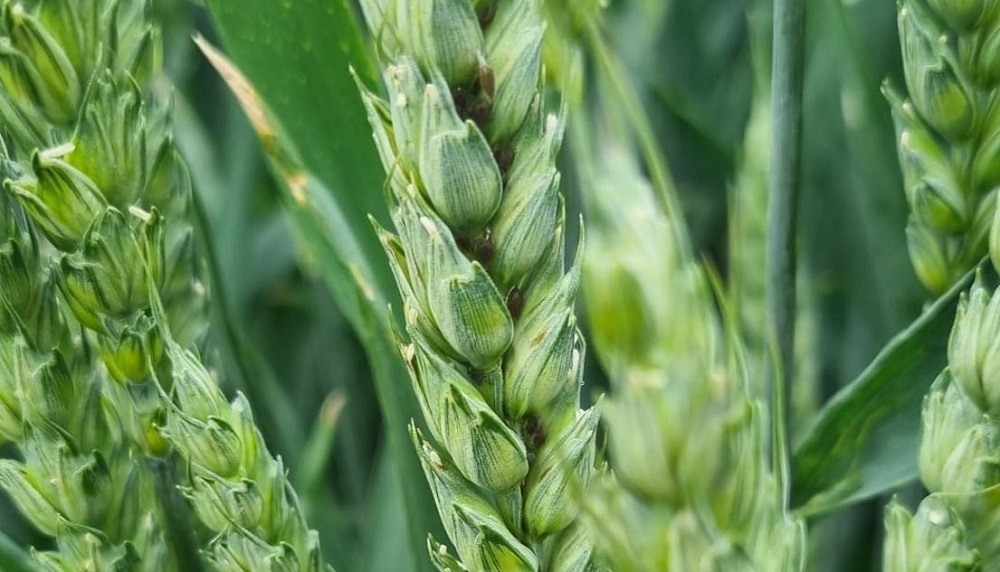- Home
- Knowledge library
- Basic biology of the grain aphid
Basic biology of the grain aphid
Grain aphid (Sitobion avenae) is an important vector of Barley yellow dwarf virus (BYDV) in cereals and can also cause direct feeding damage. The aphid also transmits Potato virus Y (PVY) in potatoes. Learn about its life cycle and the key features to help you identify and manage it.
Life cycle and identification
The grain aphid is 1.3–3.3 mm long, ranges from green to reddish-brown to almost black and has long, yellow legs with dark patches. The siphunculi (at the rear) are black.
- Dec–Mar: Adults overwinter on crops and grasses (they do not have an alternative woody winter host).
- Apr–Jul: Fresh migrations infest crops from April. During dry, settled weather, numbers can increase rapidly. Migration during late June and early July (e.g. from cereals) poses the greatest risk to potato crops.
- Apr–Aug: Direct feeding in cereal crops occur. When severe, leaves yellow and senesce prematurely.
- Sep–Mar: In autumn, winged forms migrate to newly emerged cereal crops (in most years, aphid flights stop when temperatures drop below about 11ºC), where multiple generations occur.*
Some grain aphids have a sexual life cycle, with eggs laid in the autumn on grasses and cereals. These eggs can survive through the winter and hatch in spring.
Note: Approximate months shown.
 life cycle (cereal disease).PNG) AHDB
AHDB
Virus (BYDV) management (autumn)
Monitoring
Initially, aphids colonise relatively few cereal plants. However, the second generation tends to move away from the plant originally colonised. Controlling this generation is a key part of a BYDV management strategy.
*Air temperature influences aphid activity. Models can predict the speed at which aphids will multiply. The critical second generation is likely to be present when accumulated daily air temperatures, above a baseline temperature of 3ºC, reach 170 – the temperature sum (T-Sum) value. T-Sum calculations should start either:
- On the day of crop emergence.
- Following an insecticide application (account for product persistence, see label).
Let our BYDV tool make T-Sum calculations for you
Treatment threshold
Since there is insufficient information on the prevalence of virus-carrying aphids, assume grain aphids carry BYDV.
Note: Moderate levels of pyrethroid resistance are widespread in the UK.
Risk factors
- Early sown winter cereal crops tend to be the highest risk
- Risk is greater in mild winters, as winged aphids migrate later into the season
- Spring crops may be vulnerable following mild winters
- BYDV is most damaging in cereals if infection occurs before growth stage 31
- The presence of grass weeds, other cereal crops and volunteers increases the risk of virus transmission
- Fields in landscapes with a large amount of grassland and coastal fields in the South West are also at higher risk
Direct feeding damage (summer)
The aphid also causes direct feeding damage and indirect damage by honeydew secretion during feeding, which encourages sooty moulds to develop and provides a sugar source for flies, including some pest species.
Monitoring
To monitor direct feeding damage, check for aphids on the leaves, initially at about the same time that cereals are coming into ear. Individuals move up to the ears during grain filling and feed from the phloem supply to the grain.
Treatment thresholds
- Before the start of flowering (growth stage 61): 50% of tillers infested
- After the start of flowering (growth stage 61) to 2 weeks before end of grain filling: 66% of tillers are infested and aphid numbers are increasing
Note: Moderate levels of pyrethroid resistance are widespread in the UK.
Risk factors
- The earlier senescence of winter barley puts it at lower risk
- Crops affected by drought, pests and diseases suffer more
- Dry, settled weather during early grain filling increases risk
- Outbreaks tend to occur after colder winters, which reduce natural enemy populations more than populations of these cold-hardy aphids
 AHDB
AHDB
Further information
.jpg) Dewar Crop Protection
Dewar Crop Protection

